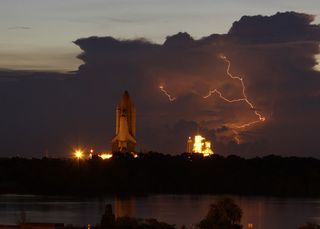Lightning Slows Space Shuttle's Launch Pad Trek

The spaceshuttle Discovery rolled out to its Florida launch pad Tuesday in an arduous, slow trekmade even slower by brilliant lightning flashes and soggy mud.
Engineers began moving Discovery out to the seaside Pad 39A at NASA's Kennedy Space Centerbefore dawn Tuesday to begin priming the shuttle for its planned Aug. 25 launchtoward the International Space Station. Distant lightning lit up the sky abovethe Cape Canaveral spaceport, providing a stunning backdrop for the shuttle?splodding move.
The tripnormally takes about six hours, but weather-related concerns pushed Discovery?sslow move beyond the 11-hour mark.
Stormy,soggy weather
NASA initiallydelayed Discovery?s trip by nearly two hours in order to keep shuttletechnicians inside and safe from potential lightning strikes at the launchsite. By 2:07 a.m. EDT (0607 GMT), it was safe to begin moving Discovery but stickymud from recent thunderstorms forced engineers to stop repeatedly to clean thegiant treads of NASA?s 5.5 million-pound (2.4 million-kg)?Apollo-era crawlercarrier vehicle that hauls shuttles out to the launch pad.
?We hadtorrential rain here yesterday evening,? NASA spokesperson Allard Beutel toldSPACE.com from the spaceport. ?It rained for hours ? so it was pretty soggy.?
Despite thelightning and mud delays, shuttle technicians were more concerned about movingDiscovery to the launch pad ahead of stormy weather that was expected to hit thespaceport Tuesday afternoon.
Get the Space.com Newsletter
Breaking space news, the latest updates on rocket launches, skywatching events and more!
A talllightning mast and shell-like protective structure at the launch pad can guardshuttles against lightning and stormy weather, but the spacecraft and theirsupport crews are exposed to the elements when they make the short 3.2-mile (5-km)trek from NASA?s massive Vehicle Assembly Building and Pad 39A.
Bolts of lightning struck11 times near the shuttle launch pad last month, causing one of a series of delaysfor Discovery?s sister ship Endeavour. That shuttle ultimately launched to theInternational Space Station on July 15 and landed July 31.
COLBERTaims for space
Commandedby veteran astronaut Rick Sturckow, Discovery is slated to fly a 13-daymission to replace one member of the space station?s six-person crew anddeliver new supplies and experiments. Three spacewalks are planned to upgrade thestation?s cooling system and European Columbus laboratory.
The shuttlewill also deliver the station?s new COLBERT treadmill, which is named aftercomedian Stephen Colbert, when it arrives at the space station.
Sturckowand his crew will arrive at the Kennedy Space Center Wednesday to begin athree-day training session that will end with a launch dress rehearsal and shuttleescape drill on Friday. Meanwhile, shuttle engineers plan to replace afaulty valve on Discovery?s left solid rocket booster over the next week.
?We have nomargin, no cushion, in the schedule at all,? said Beutel, adding that there isa possibility Discovery may be ready to fly on Aug. 24.
NASA hasuntil Aug. 30 to launch Discovery before it would stand down to late Septemberdue to a conflict with a new Japanese cargo ship test. Japan?s first H-2Transfer Vehicle, an unmanned space freighter, is slated to begin its maidenflight to the space station on Sept. 10.
- Image Gallery - Lightning on Earth
- Why Lightning Struck the Shuttle Launch Pad
- Video - Shuttle Escape Drill: Danger at the Pad!
Join our Space Forums to keep talking space on the latest missions, night sky and more! And if you have a news tip, correction or comment, let us know at: community@space.com.

Tariq is the Editor-in-Chief of Space.com and joined the team in 2001, first as an intern and staff writer, and later as an editor. He covers human spaceflight, exploration and space science, as well as skywatching and entertainment. He became Space.com's Managing Editor in 2009 and Editor-in-Chief in 2019. Before joining Space.com, Tariq was a staff reporter for The Los Angeles Times covering education and city beats in La Habra, Fullerton and Huntington Beach. In October 2022, Tariq received the Harry Kolcum Award for excellence in space reporting from the National Space Club Florida Committee. He is also an Eagle Scout (yes, he has the Space Exploration merit badge) and went to Space Camp four times as a kid and a fifth time as an adult. He has journalism degrees from the University of Southern California and New York University. You can find Tariq at Space.com and as the co-host to the This Week In Space podcast with space historian Rod Pyle on the TWiT network. To see his latest project, you can follow Tariq on Twitter @tariqjmalik.
Most Popular

